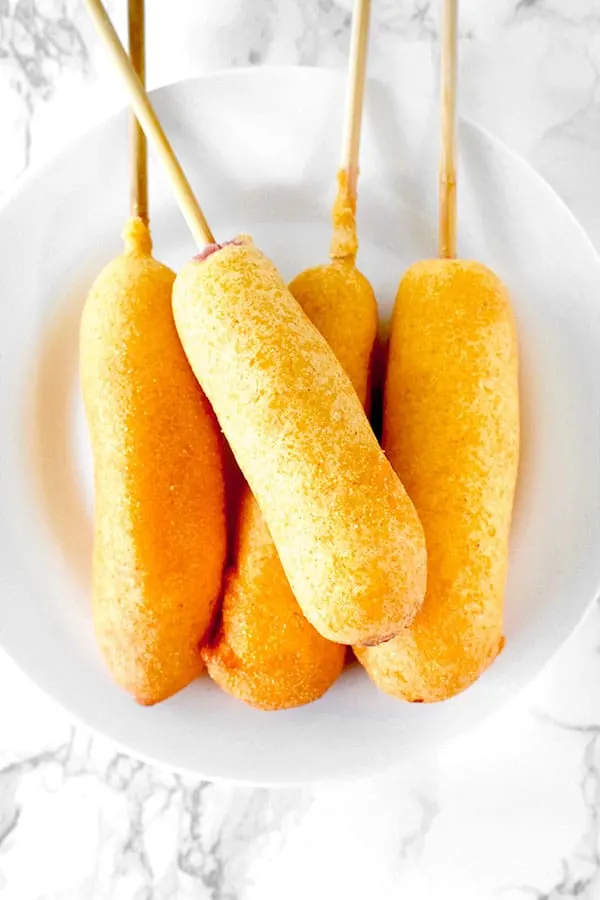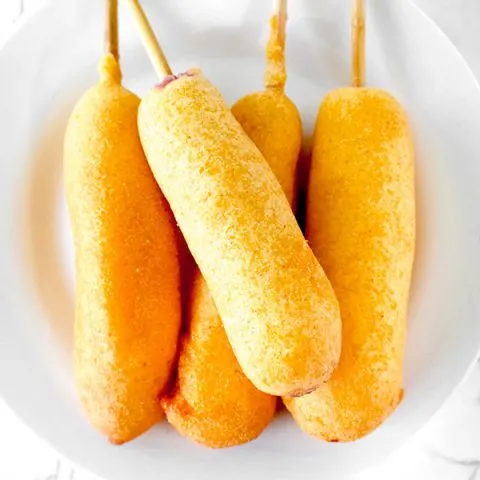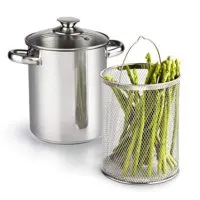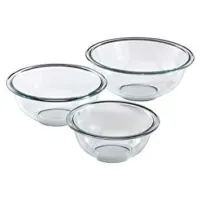These dairy free corn dogs are made without milk and are absolutely delicious!
For them to be dairy free, you have to make sure to use kosher hotdogs because non-kosher hotdogs are usually made with milk.

The first time I had a corn dog was the same day I saw Barnum and Bailey, and as it turned out, it was also the last time I'd get to see them.
It was five or so years before the circus closed and I had seen a poster on the train (subway to those not from New York).
That year the show was to take place at Coney Island instead of Madison Square Garden.
I never went to the circus before because I didn't know when it was in, and knowing it was Madison Square Garden, I assumed it would be expensive.
However, seeing that it was at Coney Island made it seem in reach. So, to my excitement, I went with my friend.
On the way, my friend told me about a sandwich shop he used to love as a kid living in Brooklyn.
We had time before the show, so we went in search of it near Avenue J.
I'm not sure if we found that same shop, or another one, but on the menu I saw corn dogs.
I just had to have one!
I had never eaten a corn dog before and it seemed perfect for the circus.
So, we bought two kosher corn dogs and drove to Coney Island, where we ate them while walking down the boardwalk.
Years later, my mother decided to try to make corn dogs for the family. They were better than I had remembered the one I had that day.
Since then, these corn dogs have been one of my favorite fun foods.
They are right up there with Southern fried chicken wings and Buffalo wings.
Equipment
wooden skewers
a pot, preferably an asparagus pot
tall or 8 ounce cup
Are corn dogs dairy?
It usually is since milk is typically used in the batter. This recipe uses water and is dairy free.
HOW TO MEASURE FLOUR AND OTHER DRY INGREDIENTS
The best way to measure dry ingredients is with a scale. However, this is not commonly done in the United States, where dry measuring cups are used instead.
To measure most dry ingredients, first spoon them into a dry measuring cup and then level off the measuring cup with an upside-down butter knife.
Make sure not to pack it down because it can lead to using more of the ingredient than called for.
The exception is brown sugar. To measure brown sugar, pack it into the measuring cup and then level off any excess.
To measure chocolate chips, nuts, or dried fruit, just pour them in and then level them off.
DRY VS LIQUID MEASURING CUP
Dry measuring cups are a set of cups that often come with measuring spoons. Each cup is a different measurement just like each spoon is a different measurement.
Liquid measuring cups, on the other hand, are cups that have measuring lines on the side to mark the measurements.
The problem with using liquid measuring cups to measure dry ingredients (like flour and cocoa) is that they are powders. So, as you shake the cup to level them off, the powders settle and you end up with more than you need.
I tested this with a friend who didn't believe me and we ended up with a number of tablespoons more than the recipe called for.
WHY sift Powdery Ingredients
There are a number of benefits to sifting powdery ingredients like flour and cocoa.
First of all, flour is often sifted before use to aerate it and remove any lumps. This helps in achieving a lighter texture in baked goods.
Secondly, if you measure flour that's just been sifted, you can get a more accurate measurement than from flour that's been packed tightly in a bag.
In addition, sifting dry ingredients together, such as flour, cocoa, and baking powder, helps make sure they're evenly dispersed.
Sugar
The primary role of sugar is to be a sweetener. However, sugar also contributes to the tenderness and moistness of the baked good by absorbing and retaining moisture and helps create the golden brown color when baking as it caramelizes.
Recipes with more sugar often result in softer, moister textures. However, I learned the hard way that too much sugar leads to a sticky mess.
When it's heated, sugar caramelizes, resulting in a rich, complex flavor and a brown color. This adds both flavor and color to baked goods and is also the process in which caramel sauce, dulce de leche, caramel candies, and regular candies are made.
When used in recipes containing yeast, the sugar is eaten by the yeast, producing carbon dioxide and causing the dough to rise.
Sugar also acts as a preservative in jams, jellies, and fruit preserves by reducing water activity and preventing microbial growth.
There are many different types of sugar, including white sugar, brown sugar, vanilla sugar, powdered sugar, turbinado sugar, and demerara sugar.
When a recipe calls for “sugar” without specifying anything else, it's referring to regular white sugar.
White Sugar
White sugar (sometimes called granulated sugar, table sugar, or white granulated sugar) is made of either beet sugar or cane sugar, which has undergone a refining process.
It is the easiest to find and most commonly used.
Brown Sugar
Brown sugar is white sugar with molasses added to it.
It is commonly used in chocolate chip cookie recipes, and it’s rare for a recipe that calls for brown sugar not to also call for white sugar as well.
When a recipe calls for “brown sugar” but doesn’t specify what type (light or dark), it is referring to light brown sugar.
In my recipes, you can use whatever type of brown sugar you have on hand, whether it is dark brown sugar, light brown sugar, or demerara sugar - which is very common in Israel.
Just keep in mind that the flavor and color will be slightly different, depending on what you choose to use.
Turbinado Sugar
Turbinado sugar is better known as "raw sugar." But, despite this name, the sugar is not really “raw.”
Instead, it's partially refined sugar that retains some of the original molasses.
The term "raw sugar" may also give off the impression that it is somehow healthier.
In reality, turbinado sugar is nutritionally similar to white sugar.
Demerara Sugar
Demerara sugar is very popular in Israel and is especially delicious in tea, but is also used for baking.
Unlike white sugar, demerara sugar undergoes minimal processing and retains some vitamins and minerals.
However, it is still not much healthier than white sugar.
Vanilla Sugar
Vanilla sugar is not very common in the States. However, it is common in Israel and parts of Europe.
This is sugar that sat for an extended period of time with vanilla beans, giving it a vanilla flavor.
Caster Sugar
This type of sugar is common in the United Kingdom.
It has a grain finer than white (granulated) sugar and larger than powdered sugar.
Caster sugar is often called for in recipes for delicate baked goods like meringues, souffles, and sponge cakes.
You can use a 1:1 conversion rate between caster sugar and white (granulated) sugar.
Powdered sugar
Powdered sugar, sometimes known as confectioners’ sugar, is a sugar with a powdered texture.
This sugar is rarely used for baking. Instead, it is used for dusting desserts and making frosting, icing, and glazes.
In some countries, you can also find powdered vanilla sugar.
It is made the exact same way regular vanilla sugar is made. However, the sugar used is powdered instead of granulated.
Vanilla Extract vs Vanilla sugar
In my recipes, I don’t specify what kind of vanilla to use.
The reason for this is that in the States, vanilla extract is exclusively used.
Meanwhile in Israel, along with many European countries, vanilla sugar is common.
In most, if not all recipes, both vanilla extract and vanilla sugar can be used.
In recipes where vanilla sugar can be used instead of extract, you can replace them 1:1.
Replacing Sugar with Honey
If you’d prefer to use honey instead of sugar, you can do so with pretty good results.
Honey can be two or even three times as sweet depending on the honey, so for every 1 cup of sugar, you can use ½ to ⅔ cup honey.
Since honey adds liquid, you need to remove some to balance it out. For every cup of honey, remove a ¼ cup of liquid.
Also, it burns faster than granulated sugar, so you want to lower the baking temperature by 25 F. In addition, check it early and often to avoid burning or overbaking.
How to Store Sugar
Sugar should be stored in an airtight container to prevent clumping and moisture absorption, and kept in a cool, dry place.
BAKING SODA VS BAKING POWDER
Both baking soda and baking powder are leavening agents, which means that they help baked goods rise. However, they're not the same thing and they are not interchangeable.
Using baking soda instead of baking powder can give your recipe a terrible metallic taste, while using baking powder instead of baking soda leaves your baked goods looking flat.
BAKING SODA
When baking soda (also known as sodium bicarbonate) is combined with acidic ingredients and exposed to heat, it causes batter or dough rise and contributes to their light and fluffy texture.
However, baking soda is a versatile ingredient. It can be sprinkled over meat to tenderize it and it can be added to tomato sauce to neutralize the acidity.
Baking soda, when combined with an acid - such as cream of tartar, lemon juice, buttermilk, cocoa, and vinegar - creates carbon dioxide. When the carbon dioxide is released, it causes the familiar texture and crumb in pancakes, cakes, quick breads, soda bread, and other baked and fried foods.
A good rule of thumb is to use around ¼ teaspoon of baking soda per 1 cup of flour.
BAKING POWDER
Baking powder is created by combining baking soda, cream of tartar, and sometimes cornstarch.
Since baking powder already contains an acid, it's most often used when a recipe does not call for an additional acidic ingredient or calls for too little of one.
There are two types of baking powder. Single-acting baking powder and double-acting baking power.
Single-acting baking powder gets activated only once - when it gets wet.
Most baking powder sold is double-acting. This means that the leavening occurs in two steps.
The first is when the baking powder gets wet, which is why you cannot prepare some batters ahead of time to bake later. The second step is when the baking powder is exposed to heat, which happens when the batter is baked or fried.
A good rule of thumb is to use around 1 teaspoon of baking powder per 1 cup of flour.
WHY SOME RECIPES CALL FOR BOTH
Some recipes use both baking soda and baking powder because they need extra leavening that the baking soda alone cannot provide.
In these cases, baking soda provides an initial lift, while baking powder provides additional rise.
WHICH ONE IS STRONGER?
You may have already guessed the answer since baking soda is used to make baking powder and you need more baking powder per cup of flour. But I’ll tell you anyway.
Baking soda is four times stronger than baking powder.
That's why you will, more often than not, see recipes that only call for baking soda rather than recipes that only call for baking powder.
HOW LONG DO THEY LAST?
BAKING SODA
Baking soda is good indefinitely past its best by date, although it can lose potency over time.
A good rule of thumb is two years for an unopened package and six months for an opened package.
However, to be honest, I’ve used very old baking soda with good results.
BAKING POWDER
Like baking soda, baking powder is good indefinitely past its best by date, and can lose its potency over time.
For both opened and unopened, it’s ideal to use it within nine months to a year.
While storing it, make sure to keep it in a dry place and away from humidity.
HOW TO TEST IF IT’S STILL GOOD
BAKING POWDER
To test baking powder, pour 3 tablespoons of warm water into a small bowl, add ½ teaspoon of baking powder, and stir.
If the baking powder is good to use, it should fizz a little.
BAKING SODA
To test baking soda, pour 3 tablespoons of white distilled vinegar into a small bowl, add ½ teaspoon of baking soda, and stir.
The mixture should rapidly bubble if the soda is fresh.
Recipe Tip:
If you plan on making corn dogs often enough, it is worthwhile to invest in an asparagus pot. These pots are tall and narrow, allowing you to use less oil.
Dairy Free Corn Dog

These dairy free corn dogs are easy to make and delicious with just a touch of sweetness.
Ingredients
- 1 cup cornmeal (150 grams)
- 1 cup all-purpose flour (120 grams)
- ¼ cup white sugar (50 grams)
- 2 teaspoons baking powder
- ½ teaspoon salt
- 1 egg
- 1 cup water (240 milliliters)
- 8 kosher hotdogs
- Oil for frying
Instructions
- Fill a(n ideally tall and narrow) pot up most of the way with oil. Heat.
- Whisk together cornmeal, flour, sugar, baking powder, and salt in a mixing bowl. Then, add the egg and water and mix until a smooth batter forms.
- Pour batter into a tall cup. Fill about ¾ high.
- Lightly coat each hotdog with flour. Shake off the excess and put the hotdog on a skewer.
- Dip in the batter. Remove and let the excess drip off. Then, slowly put the hotdog in oil. Repeat with the next hotdog. Make sure not to crowd the pot.
- Remove each hotdog when it becomes golden brown.
Notes
*If you are making this recipe because you are dairy free rather than because you keep kosher, still make sure to use kosher hotdogs. Some non-kosher hotdog companies add dairy to their hotdogs.
Recommended Products
Some of the links below are affiliate links, which means that if you choose to make a purchase, I will earn a small commission. This commission comes at no additional cost to you.
Nutrition Information:
Yield:
8Serving Size:
1Amount Per Serving: Calories: 300Total Fat: 15gSaturated Fat: 6gTrans Fat: 0gUnsaturated Fat: 7gCholesterol: 51mgSodium: 679mgCarbohydrates: 32gFiber: 2gSugar: 7gProtein: 9g


Marc
Wednesday 25th of January 2023
Being in South Africa corn dogs are not really seen, but the kids saw them in various media and asked for them. I used this recipe and they loved them! I didn't have a tall pot(and no shops here seen to have them) but found using a loafntin and laying them into it worked great.
ElissaBeth
Sunday 12th of February 2023
Oh I am so glad to hear that! Thanks for sharing :)
Chaya
Tuesday 21st of December 2021
Should the hotdogs be cooked before you put them in the batter or they will be cooked once coated?
ElissaBeth
Thursday 23rd of December 2021
They cook once they are coated
Lisa
Sunday 16th of May 2021
Can these be frozen?
ElissaBeth
Thursday 20th of May 2021
Yes, and then just bake them to reheat
Sivi
Sunday 6th of September 2020
Wow thank you for a great recipe! The corndogs came out PERFECT. Never thought making corndogs could be so easy, especially ones that are dairy-free.
ElissaBeth
Tuesday 8th of September 2020
You're welcome! I'm really glad to hear you enjoyed this recipe so much, it's definitely one of my favorites :)